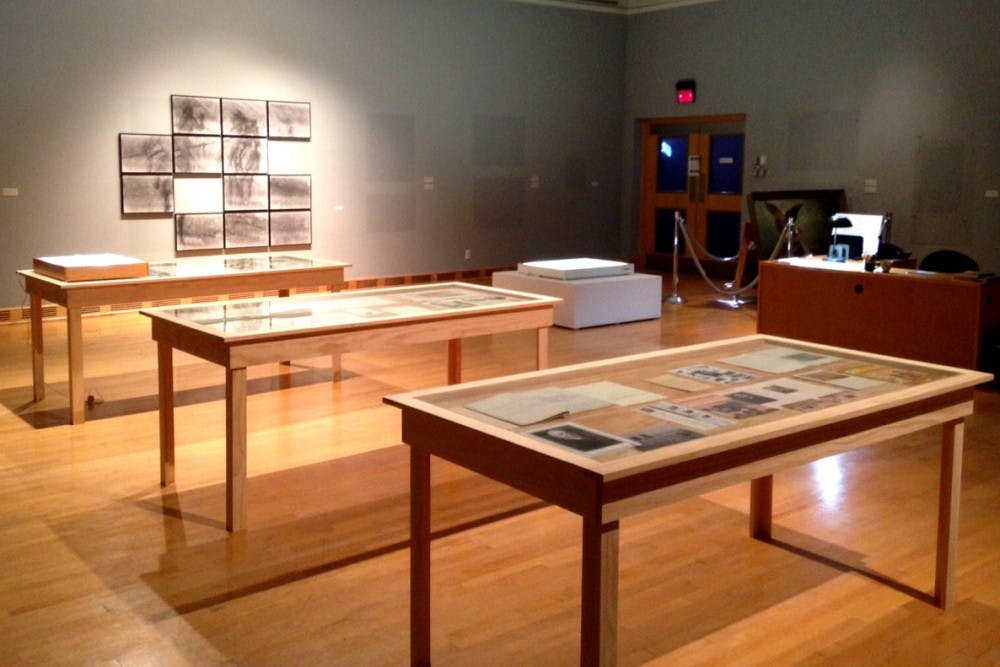Imagine that the vast majority of wall space in the ASU Art Museum's latest exhibition is occupied by blank outlines of paintings past. Only two tangible works hang on the walls, and they both represent something fake.
Which is worse, the emptiness or the falsity?
Superfake/The Parley is an exhibition conceived and implemented by Danish artist collective group, Superflex, and attempts to answer this question by presenting a Frederic Remington painting long beloved by fans of the Old West by proving that the version hanging in the ASU Art Museum is a knockoff.
Museum curator Julio Cesar Morales said the empty spaces were an intentional addition to the overall vibe of the gallery.
"It's like when you go into an old house and there's been a photo there forever and you see the fade mark," Morales said. "We wanted that kind of ghost-like imagery in the gallery as well."
The biggest source of tension in the room is of course not the blank spots, but the "original" painting was found to be a replica after being displayed for over four decades. Experts began corresponding with each other over the authenticity of the painting in 1991, and Superflex stepped in to conduct various experiments and add new dimensions to the work.
#preview#theparley
Posted by ASU Art Museum on Friday, January 8, 2016
Morales said the declaration of something as authentic or fake comes about through three steps, all of which are on display. First, the history of the artwork and the paperwork documenting its acquisition is examined. Then experts take a look at the work and keep an eye out for anything that might be awry. Later, the work of art undergoes detailed scientific testing. In this case, the Remington piece was examined through x-ray photography, infrared photography and paint tests.
The infrared photography showed the presence of line drawings in the version that hangs in the museum. This was a major indication of its falsity, as Remington never sketched his work before he painted.
Superflex has been in residence at the museum's International Artist Residency Program at Combine Studios in downtown Phoenix since 2013, where they have been working on developing the "tools" for this exhibition.
According to its website, the three-person collective refers to its projects as "tools" in an effort to emphasize the viewer's ability to engage with, utilize and modify them.
In order to do this, Superflex created both scientific and artistic representations to accompany this piece, including a slow-motion video that recreates the fictional events taking place between the native and the pioneer in the Remington painting.
Morales said the men of the group were first exposed to the Old West through a comic series called "Lucky Luke." One issue happened to mention Frederic Remington, further igniting their interest in his work and leading them to select this painting.
He noted that Remington was known to paint things that didn't actually happen in real life — ironic, considering the nature of the exhibit.
"Part of the fakeness of this exhibition extends to the actual fabrication in some of his work as imagery," Morales said. "It's a whole mythology about the West he helped create."
According to Morales, Superflex's collective mission is very much based around the community at large, and said they strive to create "socially engaged artwork" that he feels fits well with the mission of the ASU Art Museum.
In this case, the societal engagement means forcing viewers to contemplate the value of a work of art in the wake of its newly revealed falsity.
"What’s the emotional value of an artwork if you’ve seen this all your life and all of a sudden it’s fake?" Morales asked. "How does that make you feel? Is that gonna de-value it?”
Viewers can decide for themselves until April 30 at the ASU Art Museum.
Related Links:
Six Andy Warhol works donated to ASU Art Museum
Reach the reporter at celina.jimenez@asu.edu or follow @lina_lauren on Twitter.
Like The State Press on Facebook and follow @statepress on Twitter.




